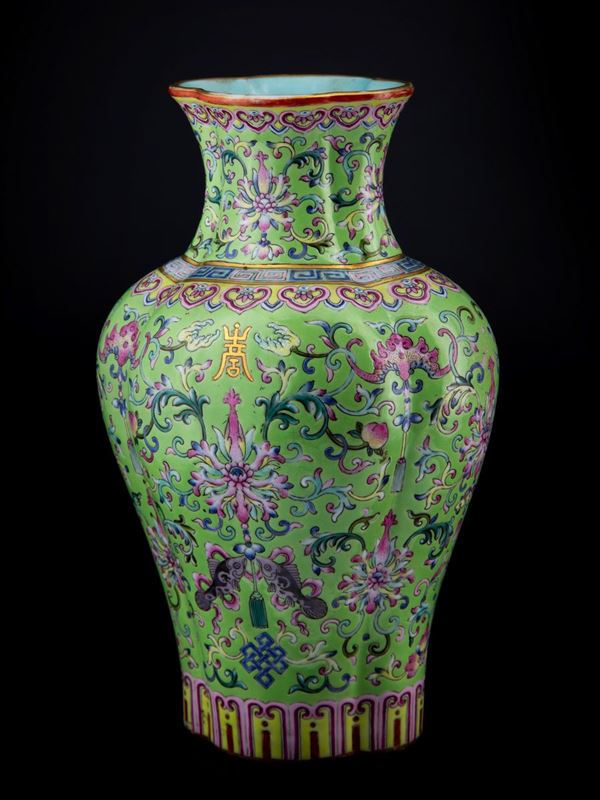*PREMIUM: A RARE IMPERIAL LIME-GROUND FAMILLE ROSE QUATREFOIL VASE, HAITANGPING, China, Qing dynasty, Jiaqing mark and period (1796 - 1820)
Beautifully shaped with a narrow neck in the centre and a broad shoulder that gradually narrows to the foot, it is finely painted on the body and neck with lotus flowers in famille rose shades, which stand out against the lime green background.
The large central flower is supported by tendrils of waving leaves held by bats with outstretched wings, beneath which appear the Two Golden Fishes and the Infinite Knot. Shou characters, peaches and Buddha's hands enrich the scene; a band of ruyi and classical greek encircles the shoulders and a band of petals tightens around the base. The inside of the vase is covered with a light turquoise glaze from below the gilded, iron-red rim; in the centre of the base, also turquoise, is the six-character seal mark in iron-red of the Jiaqing Emperor.
Provenance: -Monique Mardellis, London - according to the label.
-Private collection, Spain.
Catalogue Notes: Haitangping is the Chinese term for this particular silhouette, meaning 'begonia-shaped'.
See the Jiaqing mark and period vase of the same form and similar decoration, but painted in gold on a coral red ground, see Christie's, live auction 2861; The Imperial Sale; 01 June 2011, Hong Kong; lot. 3654.
The decoration on a lime green ground with famille rose enamels is typical of the Jiaqing period, in direct continuity with the imperial style prevalent during the previous Qianlong reign.
This rare vase is rich of auspicious symbols such as Shou characters, peaches and Buddha's Hands, emblems of health, happiness and long life. The Two Golden Fishes and the Infinite Knot are two of the eight bajixiang, the eight auspicious symbols of Buddhism.
For a Jiaqing mark and period piece, famille rose on a lime green ground, decorated with lotus flowers amidst auspicious characters and auspicious symbols, see the vase from the Qing Court Collection at the Palace Museum in Beijing illustrated in The Complete Collection of Treasures of the Palace Museum: Porcelains with Cloisonné Enamel Decoration and Famille Rose Decoration, Hong Kong, 1999, p. 195, pl. 172. See also the vase, also from the Qing Court Collection, at the Palace Museum in Beijing illustrated in the same book on p. 196, pl. 173.
See also the two famille rose vases on a lime green ground in the collection of the National Palace Museum in Taipei, object number 中瓷004090N0000000 and object number 中瓷004091N0000000. See also the lime green and pink family wall vases with auspicious symbols also in the collection of the National Palace Museum in Taipei, object number 中瓷000615N0000000, image code C1B000615N0000000PAB; object number 中瓷000616N0000000 and object number 中瓷000617N0000000.
See also the vase sold by Christie's, live auction 3220; The Yiqingge Collection of Chinese Ceramics; 29 May 2013, Hong Kong; lot. 2026.
For a marked example from the Qianlong period, in the Famille Rose style on a lime green ground, see the vase in the Palace Museum, Beijing illustrated in The Complete Collection of Treasures of the Palace Museum: Porcelains with Cloisonné Enamel Decoration and Famille Rose Decoration, Hong Kong, 1999, p. 141, pl.123.
* Only room or telephone bids are accepted for this lot.
































